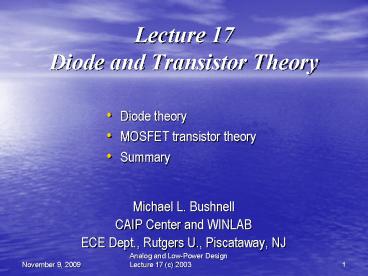Lecture 17 Diode and Transistor Theory PowerPoint PPT Presentation
1 / 16
Title: Lecture 17 Diode and Transistor Theory
1
Lecture 17Diode and Transistor Theory
- Diode theory
- MOSFET transistor theory
- Summary
- Michael L. Bushnell
- CAIP Center and WINLAB
- ECE Dept., Rutgers U., Piscataway, NJ
2
Diode Modeling
- Model necessary semiconductor junction aspects in
analog circuit models - Breakdown voltage and output resistance depend on
reverse-biased pn-junction depletion region
properties - Space charge region
- ND cm-3 n region doping (constant)
- NA cm-3 p region doping (constant)
- Built-in potential Y0 VT ln
- VT k T / q 0.026 V at 300o K
NA ND ni2
3
Diode Model
4
Depletion Region Widths
- Conservation of charge W1 NA W2 ND
- Poissons equation (in 1 dimension)
5
Depletion Region Widths (contd)
- Linear e Integrate to get
- Let V 0 for x - W1
- At x 0, define V as V1
- Potential difference from x 0 to x W2 is V2
- Total junction voltage
6
Depletion Region Properties
- p side penetration
- n side penetration
- Depletion Region Capacitance
- A junction cross-sectional area
7
Depletion Region Properties
- Leading to
- Valid for reverse bias VR, and for forward bias,
provided a small current flows. - If VD is junction bias then
8
pn Junction Depletion-layer Capacitance as f
(Bias Voltage VD)
9
Avalanche Breakdown
- When reverse saturation current carriers get
sufficient energy at ecrit they collide with
silicon lattice atoms and create new
electron-hole pairs -- Avalanche breakdown
10
Avalanche Breakdown
- Reverse avalanche current near breakdown
- IRA M IR
- M (multiplication factor)
, 3 n 6 - BV breakdown voltage
- Relevance Diodes operating at avalanche
breakdown (Zener diodes) are commonly used as
voltage references - Zener breakdown different in heavily-doped
junction, e becomes large enough to strip e--
from valence bands tunneling - Works only for BV lt 6 V
1
11
Cross Section and Top View of n- Channel
MOS Transistor
- Depletion width under oxide
- f potential in depletion layer at Si SiO2
interface - Depletion region charge
12
nMOS Cross Section With Positive VGS Applied
- Channel inverts when potential in Si reaches 2
ff, ff 0.3 V
13
MOSFET Transistor
- When inverted, with no substrate bias, depletion
region contains fixed charge - With substrate bias VSB
- Threshold voltage
1
14
Large-Signal Behavior
- Induced channel charge
- nd saturation drift velocity
- W device width
- L channel length
- Voltage drop in channel along dy
15
Large-Signal Behavior (continued)
- Substitute integrate
- Or
- When we enter saturation, drain end pinches off
(like JFET) - Finding ID by replacing VDS VGS Vt
16
Summary
- Diode theory
- MOSFET transistor theory

